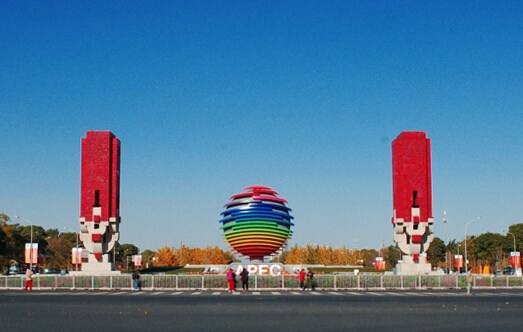'APEC blue' prompts pollution control pledge
 0 Comment(s)
0 Comment(s) Print
Print E-mail Xinhua, November 16, 2014
E-mail Xinhua, November 16, 2014
Officials in north China say the success of cutting emissions for the duration of the Asia-Pacific Economic Cooperation (APEC) meetings will prompt more measures to curb air pollution.
 |
|
"APEC blue" is a popular phrase coined by China's netizens to describe the blue sky in the heavily-polluted Beijing during the APEC week, which was a result of tough emission-reduction measures. [File photo] |
The promises were made as most polluting factories resumed production, which had been suspended or ordered to cut production to ensure clean air during the APEC meetings in Beijing.
In Hebei Province, which neighbors Beijing, some factories might be permanently phased out, said Yin Guangping, vice head of the province's environmental protection department.
"Some factories affected by the suspension order were found to be unlicensed or illegal and they might not be allowed to reopen," Yin said, adding that the province was mulling "further measures" on air pollution control.
Nearly 4,000 factories were ordered to close or curb production in Hebei during the week-long APEC meetings that ended on Tuesday. The province relies heavily on its coal-fired steel plants and emissions from the area are partially blamed for the notorious smog that plagues Beijing.
To ensure clean air during the meetings, Beijing and its neighboring regions -- including Hebei, Tianjin, Shandong and Inner Mongolia -- imposed temporary restrictions, including halting emission-heavy production and limiting cars on the streets based on their license plates.
As a result, the Beijing sky remained blue during APEC despite predictions otherwise, with daily PM 2.5 density in the period falling to 43 micrograms per cubic meter, prompting Chinese netizens to coin the phrase "APEC Blue" to describe the clear sky.
But, with the lifting of the bans, Beijing reported medium to serious air pollution on Saturday, with PM 2.5 density exceeding 200 micrograms per cubic meter in some parts of the city.
Inner Mongolia Autonomous Region, on the north of Beijing, promised to crackdown on construction sites and factories that violated pollution control rules in the wake of APEC, said Pan Yanzhao, vice head of the regions' environmental protection department.
"The APEC meetings have served to raise public awareness on the need to phase out excessive and outdated industrial capacity, so it presents a chance for us to place more pressure on heavy-polluting factories," said Ma Jinghua, vice head of Harqin Banner in Chifeng City, Inner Mongolia.
Possible despite challenges
There are concerns that the heating season, which began on Saturday, could mean more smoggy days in the coming months.
"I have to say goodbye to APEC Blue and 'welcome back' to the Beijing smog. Preventing all cars from traveling on the road is not realistic, but we still can do something," wrote Rundstedt, a user on Sina Weibo -- China's answer to Twitter.
"Indeed, it is possible," said Ma Jun, director with the Beijing Institute of Public Environmental Affairs. "We cannot control meteorological conditions, but we can reduce emissions."
During APEC week, the Beijing government took a range of measures, similar to those adopted during the Olympic Games in 2008, to improve air quality.
Some measures, including regional collaboration and ordering high-polluting factories to close or cut production, can be used in the long run, though it means local governments must make sacrifices in the short term, Ma said.
The emissions from power plants in Hebei Province could be cut by half if they strictly abided by existing rules and regulations
"Administrative order alone is not enough. Stricter supervision is needed in the future."
Ma said "APEC Blue" injected the country with confidence, assuring it that it could win the battle.






Go to Forum >>0 Comment(s)